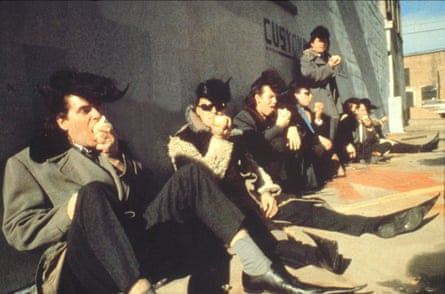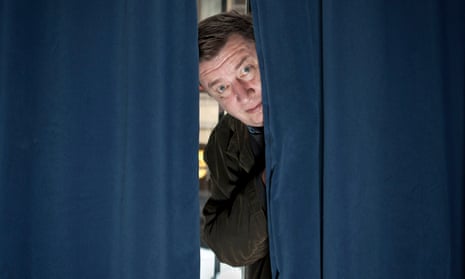Twice a year, Aki Kaurismäki climbs into his battered blue Volvo and drives from his home in a Portuguese village all the way to Helsinki. “When I was young, with my Cadillac and lousy roads, it took three days,” says the 60-year-old Finnish director. “Now, with good roads, at my age it takes five.” A shrug. What does he play on the journey? “Otis Redding. Dylan. Finnish tango. I haven’t bought new music in 20 years.”
Helsinki is the setting for most of his humane and poker-faced comedies, including The Man Without a Past, which won the Grand Prix at Cannes in 2002, and his latest gem, The Other Side of Hope. The story of a stoical restaurateur who takes a Syrian asylum-seeker under his wing, it won him the best director prize in Berlin earlier this year. Did he enjoy the festival? “Three days in a room. No smoking.” He gives me a you-do-the-maths look. “At least I had my wine.” He has his wine now, too, though he is going easy because he has to drive his dog to the vet for a knee operation.
In Helsinki, Kaurismäki is the co-owner of a complex, Andorra, that incorporates a cinema, several bars and possibly the only pool hall in the world to feature a giant poster for Robert Bresson’s L’Argent. On this chilly May afternoon, Kaurismäki unlocks one of the complex’s bars, Cafe Moscow, and leads me to a corner table. He’s a big, spongy-faced man but he moves lightly, even elegantly. He flicks on the lights and a jaundiced pall falls over the room, finalising the air of Soviet-tinged dourness familiar from his films. On the wall are two slashes of scarlet neon. Near the door sits a jukebox from his 1994 rockabilly comedy Leningrad Cowboys Meet Moses. “It’s full of Czech hits. I tried to use it once but…” His hands describe a cloud of smoke rising in the air.

In The Other Side of Hope, Kaurismäki returns to the refugee crisis, which was the subject of his previous picture, Le Havre. There is a sense, by depicting altruism in desperate times, that he is trying to foster kindness in his audience: you cannot help but emerge from his films with more faith in humanity. “That’s why I rushed this one out. I wanted everyone to see that refugees are human too. Cinema can influence a tiny bit. One penny makes a big river.”
He stops. “No, that’s not it. One penny makes a Bill Gates.” His hangdog look is interrupted by a sudden grin. Then it’s back to seriousness. “Some countries don’t take anyone. It is the biggest shame in Europe right now.” Brexit, he thinks, will only exacerbate the problem. “Europe going to pieces again is not a good idea, especially because of the extreme right-wing governments in Poland and Hungary. The Brexit propaganda worked very well and then the propaganda guys vanished like a fart in the Sahara.” He gives a grim smile. “Old Finnish saying.”
If Kaurismäki tends to be overlooked during discussions about world cinema, it can only be because his films are so funny. Were it not for the one-liners, delivered by his cast in a parched monotone, and the absurdist sight gags (the new film has some delicious ones on the topic of fusion restaurants) then he would be as esteemed as Ken Loach or the Dardenne brothers. Certainly, he navigates the same hardscrabble landscape. He tackled destitution and unemployment in The Man Without a Past and Drifting Clouds, criminality in Ariel and Lights in the Dusk, suicide in I Hired a Contract Killer, in which Jean-Pierre Léaud, unable to kill himself, pays a hitman to do the job.
Kaurismäki sets his films in a brutal world, though recoils personally from violence. “I never like showing it. And I don’t want to see it in films, especially when it is comic. On the other hand, if it is Sunday and I have a hangover, I can watch those senseless Marvel things. I’m too afraid to watch anything else in that condition. Even Holby City is too scary.” Wait – you’ve seen Holby City? “Oh, it is very nice,” he says brightly. “I’m hooked on it. The characters are well developed. But when they cut people open, I can’t watch. Whereas the superheroes, they never get harmed. Except with kryptonite.”
The new film was intended to be the second part of his River trilogy, until he announced earlier this year that it would be his swansong. He dismisses that promise now with a wave of his hand. “I always say that.” Technology will ultimately decide whether anything follows The Other Side of Hope. He shoots on film and feels too old to switch to digital. “It depends on the laboratories. There are only a few left in Europe.” Then again, he can see the upside to retirement: more time to go fishing, chop wood, play cards. “It would be nice to live a bit before I drop dead.”
In his younger days, he could make one or two pictures a year, as well act in his brother Mika’s films. “I’m paying the debt now for being too fast early on,” he groans. He has been unforgiving about his own work, but when he recently supervised the digital remastering of his back catalogue, he was pleasantly surprised. “They’re all the same story. But some are not as bad as I thought.”
Hamlet Goes Business, his 1987 Shakespearean update in which the prince blocks his family’s move into the rubber-duck industry, is “quite good”; and he thinks it was during Ariel, from 1988, that he started to use the camera properly. In that picture, the doleful hero avoids a parking ticket by asking the traffic warden on a date. Did Kaurismäki ever try that trick? “Yeah, but I didn’t have any luck,” he says, taking a commiserating drag on his cigarette.
By coincidence, when we step out on to the street, he has just received a parking ticket. “Eighty euros,” he says, staring blankly at his Volvo. He got eight while shooting The Other Side of Hope, though he claims parking is so expensive in Helsinki that it’s cheaper just to take the risk.
We stroll round the corner to a sushi joint, accompanied by Sherwan Haji, the 32-year-old Syrian who stars in the new film. He describes the director’s working style as a mix of the casual and the meticulous. “I did a long speech in Arabic with no rehearsal. Aki said, ‘I don’t know Arabic. Did you say everything?’ I said I had. Then he said, ‘OK, next shot.’ But another time, he came up, looked at the set and said, ‘Stop the scene!’ The wall was the wrong colour: it had to be repainted in a subtly different shade. The lighting, the colour, every detail is precise.”

Over sushi, Haji tries to show Kaurismäki a clip of the director fumbling with a cigarette at some festival. “What is it? No, no, I don’t do Facebook. I don’t do Instagram. I don’t do LinkedIn.” He looks exasperated. “I’m 60!” Nor does he do much publicity if he can help it. He’s sending Haji off to promote the film in Sydney. “These actors, they are so lazy. It is good for them to work.”
Back at the bar later, everyone is there. Cast members from Kaurismäki’s movies stop by to share a drink and have a smoke with him on the pavement under the heaters. The atmosphere is relaxed, the affection for him unmistakable. He asks for everyone’s numbers and taps them into his new phone. He slammed the car door on his jacket recently, he explains, only to find that – crunch! – his mobile was still in the pocket.
Before he leaves for the vet, I ask if he’s feeling hopeful for civilisation. “I like people,” he says. “I watch them in the street. I think, ‘Hmm, what’s his story? Where’s she going in such a rush?’ But mankind as a whole? I’m not so sure.”
- The Other Side of Hope is out now in the UK; 11 June in Australia.

Comments (…)
Sign in or create your Guardian account to join the discussion